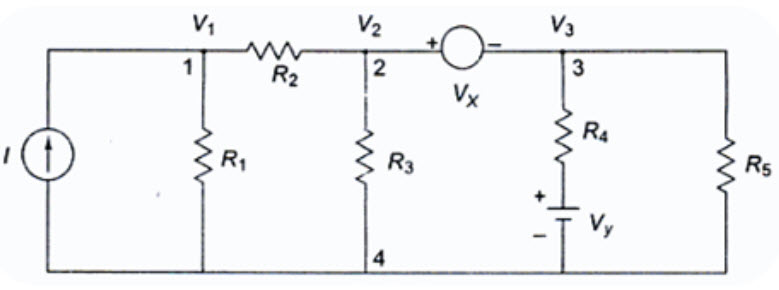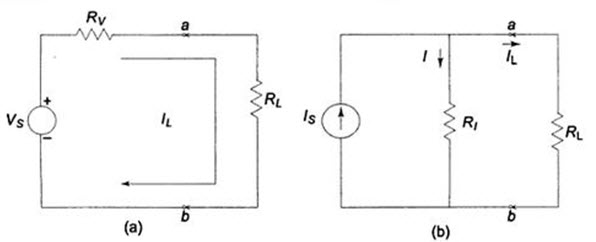Site pages
Current course
Participants
General
Module 1. Average and effective value of sinusoida...
Module 2. Independent and dependent sources, loop ...
Module 3. Node voltage and node equations (Nodal v...
Module 4. Network theorems Thevenin’ s, Norton’ s,...
Module 5. Reciprocity and Maximum power transfer
Module 6. Star- Delta conversion solution of DC ci...
Module 7. Sinusoidal steady state response of circ...
Module 8. Instantaneous and average power, power f...
Module 9. Concept and analysis of balanced polypha...
Module 10. Laplace transform method of finding ste...
Module 11. Series and parallel resonance
Module 12. Classification of filters
Module 13. Constant-k, m-derived, terminating half...
LESSON 7. Node Analysis
7.1. Supernode Analysis
Suppose any of the branches in the network has a voltage source, then it is slightly, difficult to apply nodal analysis. One way to overcome this difficulty is to apply the supernode technique. In this method, the two adjacent nodes that are connected by a voltage source are reduced to a single node and then the equations are formed by applying Kirchhoff’s current law as usual. This is explained with the help of Fig. 7.1.

Fig. 7.1
It is clear from Fig. 7.1, that node 4 is the reference node. Applying Kirchhoff’s current law at node 1, we get
\[I={{{V_1}} \over {{R_1}}} + {{{V_1} - {V_2}} \over {{R_2}}}\]
Due to the presence of voltage source Vx in between nodes 2 and 3, it is slightly difficult to find out the current. The supernode technique can be conveniently applied in this case.
Accordingly, we can write the combined equation for nodes 2 and 3 as under.
\[{{{V_2} - {V_1}} \over {{R_2}}} + {{{V_2}} \over {{R_3}}} + {{{V_3} - {V_y}} \over {{R_4}}} + {{{V_3}} \over {{R_5}}}=0\]
The other equation is
V2 – V3 = Vx
From the above three equations, we can find the three unknown voltages.
7.2. Source Transformation Technique
In solving networks to find solutions one may have to deal with energy source. It has already been discussed in Chapter 1 that basically, energy sources are either voltage sources or current sources. Sometimes it is necessary to convert a voltage source to a current source and vice-versa. Any practical voltage source consists of an ideal voltage source in series with an internal resistance. Similarly, a practical current source consists of an ideal current source in parallel with an internal resistance as shown in Fig. 7.2. Rv and Ri represent the internal resistance of the voltage source Vs’ and current source Is’ respectively.
 Fig. 7.2
Fig. 7.2
Any source, be it a current source or a voltage source, drives current through its load resistance, and the magnitude of the current depend on the value of the load resistance. Figure 7.3 represents a practical voltage source and a practical current source connected to the same load resistance RL’

Fig. 7.3
From Fig. 7.3 (a), the load voltage can be calculated by using Kirchhoff’s voltage law as
Vab = Vs – IL Rv
The open circuit voltage VOC = Vs
The short circuit current \[{I_{SC}}\,={{{V_s}} \over {{R_v}}}\]
From Fig. 7.3 (b)
\[{I_L}={I_s} - I={I_s} - {{{V_{ab}}} \over {{R_1}}}\]
The open circuit voltage VOC = Is R1
The short circuit current ISC = IS
The above two sources are said to be equal, if they produce equal amounts of current and voltage when they are connected to identical load resistances. Therefore, by equating the open circuit voltages and short circuit currents of the above two sources we obtain.
VOC = Is R1 = Vs
\[{I_{SC}}={I_s}={{{V_s}} \over {{R_v}}}\]
It follows that R1 = Rv = Rs \Vs = Is Rs
Where Rs is the internal resistance of the voltage or current source. Therefore, any practical voltage source, having an ideal voltage Vs and internal series resistance Rs can be replaced by a current source Is = Vs /Rs in parallel with an internal resistance Rs. The reverse transformation is also possible. Thus, a practical current source in parallel with an internal resistance Rs can be replaced by a voltage source Vs = Is Rs in series with an internal resistance Rs.